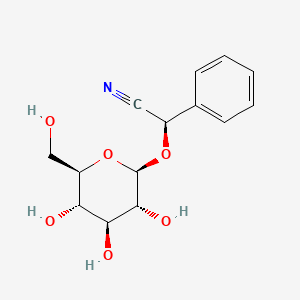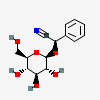Prunasin
- Prunasin
- (R)-Prunasin
- 99-18-3
- D-Prunasin
- (2R)-Prunasin
- Create:2004-09-16
- Modify:2025-01-18

- (R)-prunasin
- benzeneacetonitrile, alpha-(beta-D-glucopyranosyloxy)-
- mandelonitrile-beta-glucoside
- prulaurasin
- prunasin
- prunasin, (R)-isomer
- prunasine
- Prunasin
- (R)-Prunasin
- 99-18-3
- D-Prunasin
- (2R)-Prunasin
- (R)-(beta-D-Glucopyranosyloxy)phenylacetonitrile
- D-Mandelonitrile-beta-D-glucoside
- UNII-14W4BPM5FB
- EINECS 202-738-0
- 14W4BPM5FB
- (R)-alpha-(beta-D-Glucopyranosyloxy)benzene-acetonitrile
- (-)-Prunasin
- BRN 0091509
- CHEBI:17396
- (2R)-2-phenyl-2-[(2R,3R,4S,5S,6R)-3,4,5-trihydroxy-6-(hydroxymethyl)oxan-2-yl]oxyacetonitrile
- (-)-(2R)-Prunasin
- Benzeneacetonitrile, alpha-(beta-D-glucopyranosyloxy)-, (R)-
- DTXSID001018995
- 5-17-07-00405 (Beilstein Handbook Reference)
- (R)-mandelonitrile beta-D-glucoside
- MANDELONITRILE GLUCOSIDE D-FORM
- (R)-mandelonitrile beta-D-glucopyranoside
- MANDELONITRILE GLUCOSIDE D-FORM [MI]
- (2R)-(beta-D-glucosyloxy)(phenyl)acetonitrile
- (2R)-2-phenyl-2-{[(2R,3R,4S,5S,6R)-3,4,5-trihydroxy-6-(hydroxymethyl)oxan-2-yl]oxy}acetonitrile
- (2R)-(beta-D-glucopyranosyloxy)(phenyl)acetonitrile
- Prunasine
- Benzeneacetonitrile, .alpha.-(.beta.-D-glucopyranosyloxy)-, (R)-
- BENZENEACETONITRILE, .ALPHA.-(.BETA.-D-GLUCOPYRANOSYLOXY)-, (.ALPHA.R)-
- Prunasin, (R)-isomer
- (R)-2-Phenyl-2-(((2R,3R,4S,5S,6R)-3,4,5-trihydroxy-6-(hydroxymethyl)tetrahydro-2H-pyran-2-yl)oxy)acetonitrile
- CHEBI:25150
- D-Mandelonitrile-.beta.-D-glucoside
- (2R)-2-phenyl-2-(((2R,3R,4S,5S,6R)-3,4,5-trihydroxy-6-(hydroxymethyl)oxan-2-yl)oxy)acetonitrile
- (2R)-2-phenyl-2-((2R,3R,4S,5S,6R)-3,4,5-trihydroxy-6-(hydroxymethyl)oxan-2-yl)oxyacetonitrile
- (2R)-Prunasin; (R)-Prunasin; D-Prunasin
- Glucopyranoside, D-mandelonitrile, .beta.-D-
- Mandelonitrile, .beta.-D-glucopyranoside, D-
- PRUNASIN [INCI]
- Acetonitrile, (.beta.-D-glucopyranosyloxy)phenyl-, D-
- mandelonitrile-beta-glucoside
- Benzeneacetonitrile, alpha-(beta-D-glucopyranosyloxy)-(9CI)
- SCHEMBL377612
- CHEMBL1778417
- (R)-Mandelonitrile b-D-glucoside
- DTXCID201476997
- GLXC-19023
- (R)-Mandelonitrile I2-D-glucoside
- HY-N1548
- AKOS032948360
- (R)-Mandelonitrile b-D-glucopyranoside
- (R)-Mandelonitrile I2-D-glucopyranoside
- AS-75874
- DA-66974
- 1ST158598
- Glucopyranoside, D-mandelonitrile, beta-D-
- Mandelonitrile, beta-D-glucopyranoside, D-
- CS-0017097
- NS00079018
- (R)-(b-D-Glucopyranosyloxy)phenylacetonitrile
- C00844
- F82086
- (R)-a-(b-D-Glucopyranosyloxy)benzene-acetonitrile
- Acetonitrile, (beta-D-glucopyranosyloxy)phenyl-, D-
- Q7253027
- Benzeneacetonitrile, alpha-(beta-D-glucopyranosyloxy)-, (R)-(9CI)
- BENZENEACETONITRILE, ALPHA-(BETA-D-GLUCOPYRANOSYLOXY)-, (ALPHAR)-
- Cytoplasm
- Extracellular


H301 (100%): Toxic if swallowed [Danger Acute toxicity, oral]
H360 (100%): May damage fertility or the unborn child [Danger Reproductive toxicity]
P203, P264, P270, P280, P301+P316, P318, P321, P330, P405, and P501
(The corresponding statement to each P-code can be found at the GHS Classification page.)
Aggregated GHS information provided per 38 reports by companies from 1 notifications to the ECHA C&L Inventory. Each notification may be associated with multiple companies.
Information may vary between notifications depending on impurities, additives, and other factors. The percentage value in parenthesis indicates the notified classification ratio from companies that provide hazard codes. Only hazard codes with percentage values above 10% are shown.
Acute Tox. 3 (100%)
Repr. 1B (100%)
Patents are available for this chemical structure:
https://patentscope.wipo.int/search/en/result.jsf?inchikey=ZKSZEJFBGODIJW-GMDXDWKASA-N
- CAS Common ChemistryLICENSEThe data from CAS Common Chemistry is provided under a CC-BY-NC 4.0 license, unless otherwise stated.https://creativecommons.org/licenses/by-nc/4.0/
- ChemIDplusChemIDplus Chemical Information Classificationhttps://pubchem.ncbi.nlm.nih.gov/source/ChemIDplus
- EPA DSSToxCompTox Chemicals Dashboard Chemical Listshttps://comptox.epa.gov/dashboard/chemical-lists/
- European Chemicals Agency (ECHA)LICENSEUse of the information, documents and data from the ECHA website is subject to the terms and conditions of this Legal Notice, and subject to other binding limitations provided for under applicable law, the information, documents and data made available on the ECHA website may be reproduced, distributed and/or used, totally or in part, for non-commercial purposes provided that ECHA is acknowledged as the source: "Source: European Chemicals Agency, http://echa.europa.eu/". Such acknowledgement must be included in each copy of the material. ECHA permits and encourages organisations and individuals to create links to the ECHA website under the following cumulative conditions: Links can only be made to webpages that provide a link to the Legal Notice page.https://echa.europa.eu/web/guest/legal-notice(R)-(β-D-glucopyranosyloxy)phenylacetonitrilehttps://echa.europa.eu/substance-information/-/substanceinfo/100.002.489(R)-(β-D-glucopyranosyloxy)phenylacetonitrile (EC: 202-738-0)https://echa.europa.eu/information-on-chemicals/cl-inventory-database/-/discli/details/10079
- FDA Global Substance Registration System (GSRS)LICENSEUnless otherwise noted, the contents of the FDA website (www.fda.gov), both text and graphics, are not copyrighted. They are in the public domain and may be republished, reprinted and otherwise used freely by anyone without the need to obtain permission from FDA. Credit to the U.S. Food and Drug Administration as the source is appreciated but not required.https://www.fda.gov/about-fda/about-website/website-policies#linking
- Human Metabolome Database (HMDB)LICENSEHMDB is offered to the public as a freely available resource. Use and re-distribution of the data, in whole or in part, for commercial purposes requires explicit permission of the authors and explicit acknowledgment of the source material (HMDB) and the original publication (see the HMDB citing page). We ask that users who download significant portions of the database cite the HMDB paper in any resulting publications.http://www.hmdb.ca/citing
- CCSbaseCCSbase Classificationhttps://ccsbase.net/
- ChEBI
- LOTUS - the natural products occurrence databaseLICENSEThe code for LOTUS is released under the GNU General Public License v3.0.https://lotus.nprod.net/LOTUS Treehttps://lotus.naturalproducts.net/
- Toxin and Toxin Target Database (T3DB)LICENSET3DB is offered to the public as a freely available resource. Use and re-distribution of the data, in whole or in part, for commercial purposes requires explicit permission of the authors and explicit acknowledgment of the source material (T3DB) and the original publication.http://www.t3db.ca/downloads
- ChEMBLLICENSEAccess to the web interface of ChEMBL is made under the EBI's Terms of Use (http://www.ebi.ac.uk/Information/termsofuse.html). The ChEMBL data is made available on a Creative Commons Attribution-Share Alike 3.0 Unported License (http://creativecommons.org/licenses/by-sa/3.0/).http://www.ebi.ac.uk/Information/termsofuse.html
- EPA Chemical and Products Database (CPDat)EPA CPDat Classificationhttps://www.epa.gov/chemical-research/chemical-and-products-database-cpdat
- FooDBLICENSEFooDB is offered to the public as a freely available resource. Use and re-distribution of the data, in whole or in part, for commercial purposes requires explicit permission of the authors and explicit acknowledgment of the source material (FooDB) and the original publication.https://foodb.ca/about
- Japan Chemical Substance Dictionary (Nikkaji)
- KEGGLICENSEAcademic users may freely use the KEGG website. Non-academic use of KEGG generally requires a commercial licensehttps://www.kegg.jp/kegg/legal.htmlPhytochemical compoundshttp://www.genome.jp/kegg-bin/get_htext?br08003.kegNatural toxinshttp://www.genome.jp/kegg-bin/get_htext?br08009.keg
- Natural Product Activity and Species Source (NPASS)
- NORMAN Suspect List ExchangeLICENSEData: CC-BY 4.0; Code (hosted by ECI, LCSB): Artistic-2.0https://creativecommons.org/licenses/by/4.0/PrunasinNORMAN Suspect List Exchange Classificationhttps://www.norman-network.com/nds/SLE/
- Metabolomics Workbench
- Rhea - Annotated Reactions DatabaseLICENSERhea has chosen to apply the Creative Commons Attribution License (http://creativecommons.org/licenses/by/4.0/). This means that you are free to copy, distribute, display and make commercial use of the database in all legislations, provided you credit (cite) Rhea.https://www.rhea-db.org/help/license-disclaimer
- SpectraBase2-beta-D-GLUCOPYRANOSYLOXY-2-PHENYLACETONITRILEhttps://spectrabase.com/spectrum/Ho0rUzhSJCQ
- Springer Nature
- Wikidata(R)-prunasinhttps://www.wikidata.org/wiki/Q7253027
- WikipediaQuadrangularin Ahttps://en.wikipedia.org/wiki/Quadrangularin_A
- PubChem
- Medical Subject Headings (MeSH)LICENSEWorks produced by the U.S. government are not subject to copyright protection in the United States. Any such works found on National Library of Medicine (NLM) Web sites may be freely used or reproduced without permission in the U.S.https://www.nlm.nih.gov/copyright.htmlEnzyme Inhibitorshttps://www.ncbi.nlm.nih.gov/mesh/68004791
- GHS Classification (UNECE)GHS Classification Treehttp://www.unece.org/trans/danger/publi/ghs/ghs_welcome_e.html
- MolGenieMolGenie Organic Chemistry Ontologyhttps://github.com/MolGenie/ontology/
- PATENTSCOPE (WIPO)SID 388474793https://pubchem.ncbi.nlm.nih.gov/substance/388474793
- NCBI

